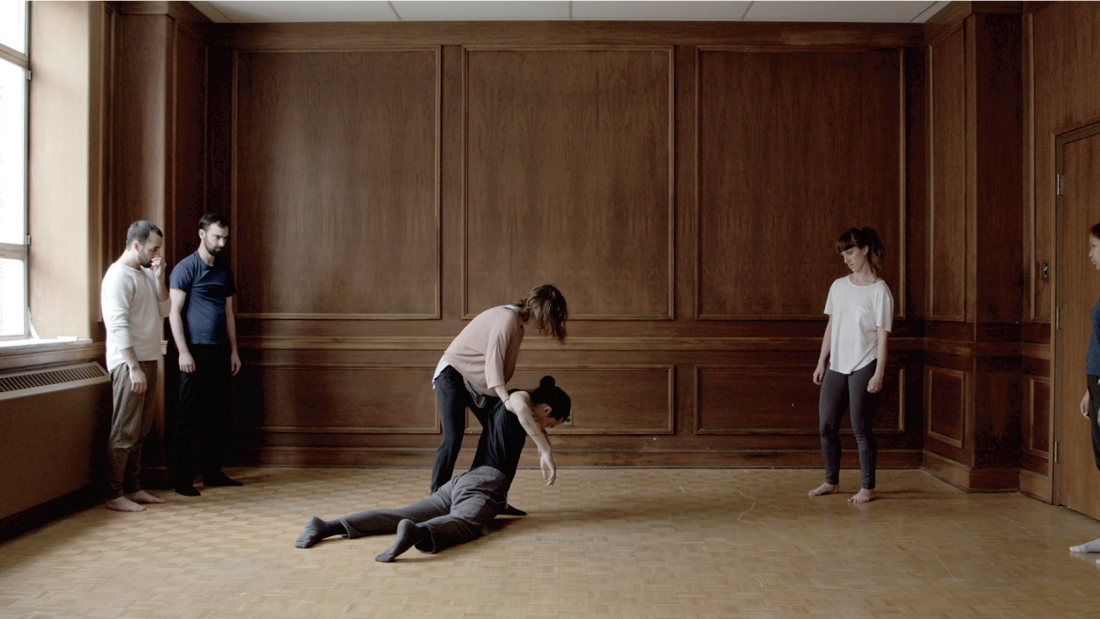Annie MacDonell
How can an authentic response to the imposed disaster of contemporary life be constructed? This question, borrowed from American artist Doug Ashford, inspired Annie MacDonell’s consideration of journalistic images of passive political resistance. The artist used photographs from The Ryerson Image Centre’s Black Star Collection and other sources as a starting point for a multichannel video installation in which she attempts to gain a better understanding of how people remain passive when confronted with aggression. She sought to appropriate the dynamic element in police-protester relationships and present a new perspective on the balance of power. To do this MacDonell worked with a choreographer and six dancers. She gave the participants instructions, “Notes for Performers: Part I” and “Part II,” which are also available to gallery visitors. These reveal the artist’s careful consideration of the roles of both police and protesters.
MacDonell’s approach offered a new way to utilize the photographic archive. However, in her process, she stripped the images of their context and presented a homogenous perspective of entirely disparate political moments in history. In “Notes for Performers: Part I” the artist acknowledges, “It is strange and awful to remove these images from their original context. It is terrible to erase from them the extended struggles that preceded the split-second they represent.” The recognition of this limitation does not relieve the artist of responsibility to the source documents.
In the first video visitors encounter, dancers plan and then execute positions shown in the photographs. The enigmatic content is elucidated as you proceed through the show.

Annie MacDonell, video still from Holding Still // Holding Together, detail, 2016. Multichannel installation. © Annie MacDonell. Image courtesy the artist and Ryerson Image Centre.
The video that dominated the exhibition presented the dancers’ graceful movements. This work superimposes various moments from the film, thereby creating an ethereal effect unlike the practical process documented in the first video. The ghostly transitions simultaneously distance us from the violence of the original images, while inviting consideration of the method of demonstration depicted in the photographs. The mindfulness necessary for effective resistance is evoked by the deliberate actions of the group.
The most provocative video shows a close-up of the face and upper body of one dancer. The subject emulates the facial expressions of individuals in the original images, accompanied by a soundtrack of street noises. Once the dancer thinks she has replicated the position of the protester, she closes her eyes revealing eyes painted on her eyelids. When her eyes are closed, the street noises are replaced by calm music, emulating an organ and played on a synthesizer. The tranquility of the music becomes disjointed as the dancer opens her eyes repeatedly to double-check the original photograph. Although the shift in the soundtrack is slightly jarring for the viewer, it clearly indicates the moment the dancer has assumed the action of the protester and the meditative state required to practice passive political resistance. In this video, MacDonell sought to re-inscribe the conflict present in the photographs. Although she eschewed working with actors, as she did not want the work to be a performance, the dancer is effectively acting in this piece, with stirring results.

Annie MacDonell, video still from Holding Still // Holding Together, detail, 2016. Multichannel installation. © Annie MacDonell. Image courtesy the artist and Ryerson Image Centre.
The artist’s process and consideration of the original images is most clearly developed in a video showing the source documents. The photographs—some black and white, others in colour—move among time periods and shift between violent and more peaceful interactions. The video is accompanied by a narration of MacDonell’s “Notes for Performers: Part II,” a guide as to how to engage as an effective protester or a non-violent figure of authority. In respect to the source images, it would have been useful if basic information about the conflicts represented was available to viewers.
This installation brings to mind Althea Thauberger’s collaborative works, which also frequently examine power dynamics. Both artists must allow for a degree of uncertainty as participants, while directed, bring subjectivity to their contribution. However, Thauberger often negotiates with members of a clearly defined community and seeks to give them an opportunity for self-expression. In contrast, MacDonell has hired dancers, who bring their own aesthetic approach, but receive extensive notes as to the artist’s vision for the project and her views of passive political resistance.
MacDonell does not provide the viewer with an answer to Ashford’s question. Instead, this work seems to suggest that mindful collaboration is necessary for an effective authentic response to the imposed disaster of contemporary life. ❚
“Holding Still // Holding Together” was exhibited at the Ryerson Image Centre, Toronto, from May 4 to August 21, 2016.
Krystina Mierins is an educator and freelance writer in Toronto.

